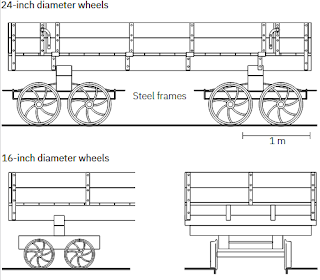A couple of weeks ago A PDF copy of a new book was shared with me. Its a surprise to find a railway in this country that I haven't heard of. In the late 1920's the Auckland city council built a dam in the upper Huia valley to supply water to the growing city.
As part of this a tramway was built to transport building materials from The Manuka harbour 6 km up the Huia river to the dam site. The tramway then ran a futher 2.5km above the dam site to a quarry.Unlike a typical bush tramway, the line was built to a much higher standard as it carried quite substantial loads of cement, sand and rock. Several bridges were required as well as a couple of tunnels.
The line from the landing on the Manakau moved sand and cement brought in by barge with a typical days load being 120 tons in 4 trains. This was carried in bogie wagons built on log bogies.
Several locos were used on the line. A Price Cb was purchased new in 1927, and a Gibbons and Harris 0-4-0 and a 9 ton Barcley 0-4-0 also worked on the project. The Cb was used to move trains from the landing to the dam site and the other 2 on the quarry line. When the dam was completed in 1929 the Quarry line was lifted and the line down to the Manakau was left for access to the dam untill it was lifted in 1959.
So, thats a rough summary of the history, whats in the book. Well, for once there's much more, and quite honestly its christmas for the modeler. A map of the line with all the interesting spots covered. Track plans for the landing, dam and quarry, along with a detailed discussion of how they were operated. There are plans for the locos (or close to) that ran on the line as well as a plan for the main type of wagon used. there are also plans (and detailed information) for the major bridges, tunnels and other locations of interest (including where the line ran across a rock shelf which had to be blasted).
Admittedly the book is writen from a historians view with detailed explanations about the difference between NZR and bush trams which for the average railway modeler are a bit long winded. Thats not why we are here. The rest of the book is absolutely brilliant and my hats off to Peter Hopcroft for writing a book which should be a blueprint for historical railway writing in this country.


.jpg)

No comments:
Post a Comment